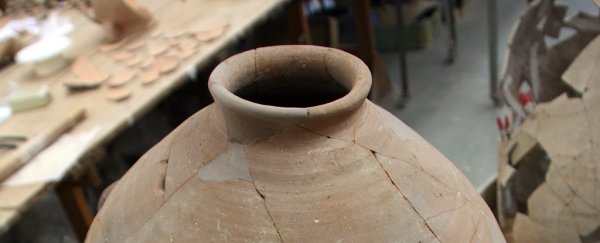Potters working in Jerusalem more than 2,000 years ago might not have been thinking too much about Earth's magnetic field, but unbeknownst to them, the clay jars they were moulding were actually recording a scientific ledger of the planet's magnetism.
Thanks to the magnetic properties of iron-oxide particles found in clay – which record the intensity of Earth's magnetic field when heated – scientists have discovered a hidden history of Earth's fluctuating magnetic field in the years from 750 to 150 BC.
"Ceramics have tiny minerals – magnetic 'recorders' – that save information about the magnetic field of the time the clay was in the kiln," researcher Erez Ben-Yosef from Tel Aviv University in Israel told The Jewish Press.
"Ceramics, baked clay, burned mud bricks, copper slag – almost anything that was heated and then cooled can become a recorder of the components of the magnetic field at the time of the event."
Ben-Yosef and his team analysed 67 ceramic storage jar handles from the Judean region, which could be accurately dated thanks to embedded royal stamps from the rulers of the time.
 Oded Lipschits/Tel Aviv University
Oded Lipschits/Tel Aviv University
Using a superconducting magnetometer to measure the strength of the magnetic field locked inside the jar fragments, the researchers found Earth's magnetic field was 40 percent stronger than it is now.
But they also found that there was also a brief spike in its strength around 700 BC, which shows that the magnetic field can fluctuate over time, and isn't simply diminishing.
"We can gain a clearer picture of the planet and its inner structure by better understanding proxies like the magnetic field, which reaches more than 1,800 miles (2,900 kilometres) deep into the liquid part of the Earth's outer core," says Ben-Yosef.
Modern records of Earth's magnetic field only go back around 200 years, and while we can glean some more information from iron-rich volcanic rocks that are several million years old, it's very hard to date these rocks with much precision.
That means any extra data we can get is very useful.
Albert Einstein called Earth's magnetic field one of the great unsolved mysteries of physics: scientists think it's caused by the liquid iron in Earth's core, which creates a giant electromagnetic dynamo circling the planet.
But we're less sure about what causes the field's strength to fluctuate. Because this magnetic shield is crucial in protecting us from solar winds and cosmic radiation, scientists are keen to understand as much as possible about the phenomena.
While the noticeable spike of 700 BC wouldn't have troubled the jar makers of ancient Judea – it would have caused chaos with today's communication and internet networks, which is why more research into the field's behaviour is so important.
Now that we know the field was much stronger a couple of thousand years ago, it could help scientists predict what it's going to do next.
Eric Blinman from the New Mexico Office of Archaeological Studies, who wasn't involved in the research, told Popular Science that similar discoveries in the future could help us piece together a more detailed record of Earth's magnetic field.
"For the geophysicists," he says, "it's like someone opened up a locked door to a library that they didn't know existed."
The research has been published in PNAS.
